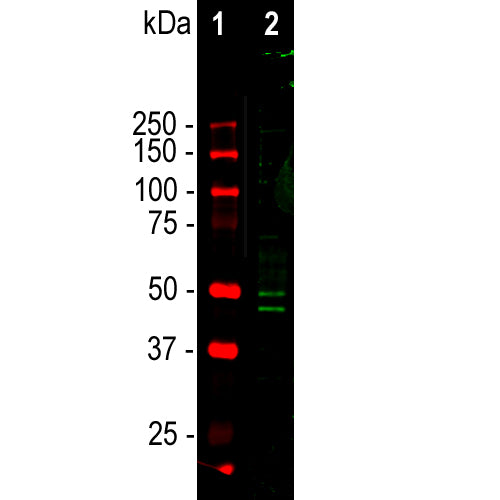





EnCor Biotechnology
Chicken Polyclonal Antibody to FOX3/NeuN (Rbfox3, Hrnbp3, A6nfn3), Cat# CPCA-FOX3
Description
The CPCA-FOX3 antibody was raised against a recombinant human FOX3 construct based only on the N-terminal sequence, not including the RRM domain and C-terminal regions. The N-terminal regions of FOX1, FOX2 and FOX3 are relatively poorly conserved so we were able to obtain antibodies which recognized FOX3 but not FOX2 or FOX1. As a result the epitopes for CPCA-FOX3 are known to be within this construct, specifically amino acids 1-99. We document that the antibody works well not only for western blotting, IF and ICC but also on formalin fixed paraffin embedded human and rodent sections, select the "Additional Data" for this data. We used the same recombinant immunogen to generate both rabbit polyclonal, goat and mouse monoclonal antibodies to FOX3, RPCA-FOX3, GPCA-FOX3 and MCA-1B7 respectively. These two antibodies also work in the same way as CPCA-FOX3 and the original NeuN antibody and are versatile reagents which can be used in double and triple staining protocols. FOX3/NeuN immunoreactivity has been used to quantify the neuron/glial ratio in the brains of rats, humans and other species (6,7). Such studies can also be performed with any of our FOX3/NeuN reagents. Mouse select image at left for larger view.
- Cell Structure Marker
- Cell Type Marker
- Chicken Polyclonal Antibodies
- Developmental Marker
- Immunohistochemistry Verified
Add a short description for this tabbed section
| Immunogen: | N-terminal 100 amino acids of human FOX3 expressed in and purified from E. coli |
| HGNC Name: | RBFOX3 |
| UniProt: | A6NFN3 |
| Molecular Weight: | 46, 48kDa |
| Host: | Chicken |
| Species Cross-Reactivity: | Human, Rat, Mouse |
| RRID: | AB_2747400 |
| Format: | Concentrated IgY preparation plus 0.02% NaN3 |
| Applications: | WB, ICC/IF, IHC |
| Recommended Dilutions: | WB: 1:500-1:1000. IF/IHC 1:5,000-1:10,000. |
| Storage: | Store at 4°C. Stable for 12 months from date of receipt. |
In the early 90s an unusual protocol resulted in the raising of a mouse monoclonal antibody against a component of neuronal nuclei and proximal perikarya (1). The component was therefore named "NeuN" and was shown to correspond to two protein bands at 46 and 48kDa in SDS-PAGE blots. The antibody become very widely used as a reliable neuronal marker, apparently binding to neurons in all vertebrates. A few neuronal cell types were not recognized by the original NeuN antibody such as cerebellar Purkinje cells, olfactory mitral cells and many type of retinal neuron. However the vast majority of neurons are strongly NeuN positive, and NeuN immunoreactivity has therefore been widely used to identify neurons.The identity of the NeuN protein was however unknown until 2009 when Kim et al. (2) showed that it was identical to FOX3, a mammalian homolog of a gene product originally identified in Caenorhabditis elegans and named FOX1 (2). The C. elegans protein was discovered as it had a role in sex determination during early development, FOX being an acronym for "feminizing locus on the X chromosome" (3). There are three mammalian FOX1 protein homologs, FOX1, FOX2 and FOX3, which are believed to have a role in the regulation of mRNA splicing (4). All three contain an almost identical central RNA recognition motif or RRM domain, a region of about 90 amino acids found in numerous proteins. The differing protein isoforms of FOX3 result from alternate splicing of two exons which code for an insert close to the C-terminus and short C-terminal extension (5). The extension includes a C-terminal proline-tyrosine sequence preceded by a hydrophobic amino acids (Φ-PY) which is known to target proteins to the nucleus, apparently accounting for FOX3 being present in both the nuclei and the cytoplasm in certain neurons (5).

Chromogenic Immunostaining of a formalin fixed paraffin embedded rat cerebellum section with chicken pAb to FOX3/NeuN, CPCA-FOX3, dilution 1:10,000, detected with DAB (brown) following the ABC method with citrate buffer retrieval. Hematoxylin (blue) was used as the counterstain. FOX3/NeuN antibody stains the nuclei and distal perikaryal of most neurons. Mouse select image for larger view.
1. Mullen RJ, Buck CR, Smith AM. NeuN, a neuronal specific nuclear protein in vertebrates. Development 116:201-11 (1994).
2. Hodgkin J, Zellan JD, Albertson DG. Identification of a candidate primary sex determination locus, fox-1, on the X chromosome of Caenorhabditis elegans. Development 120:3681-3689 (1994).
3. Kim KK, Adelstein RS, Kawamoto S. Identification of neuronal nuclei (NeuN) as Fox-3, a new member of the Fox-1 gene family of splicing factors. J. Biol. Chem. 284:31052-61 (2009).
4. Underwood JG, et al. Homologues of the Caenorhabditis elegans Fox-1 protein are neuronal splicing regulators in mammals. Mol. Cell Biol. 25:10005-16 (2005).
5. Dredge BK, Jensen KB. NeuN/Rbfox3 nuclear and cytoplasmic isoforms differentially regulate alternative splicing and nonsense-mediated decay of Rbfox2. PLoS One doi: 10.1371/journal.pone.0021585 (2011).
6. Herculano-Houzel S, Lent R. Isotropic fractionator: a simple, rapid method for the quantification of total cell and neuron numbers in the brain. J. Neurosci. 25:2518-2521 (2005).
7. Azevedo FA. et al. Equal numbers of neuronal and nonneuronal cells make the human brain an isometrically scaled-up primate brain. J. Comp. Neurol. 513:532-41 (2009).
Add a short description for this tabbed section





